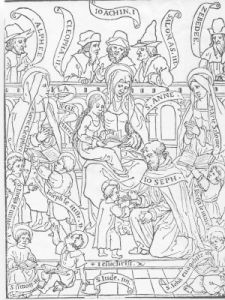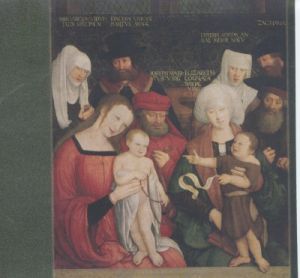Holy Kindred
Holy Kindred
– Father Johann G. Roten, S.M.
Q: What Is the Holy Kindred?
A: The Holy Kindred (la Sainte Parenté, die Heilige Sippe, La Santa Parentela) forms part of a series of themes dealing with the genealogy of Jesus Christ, as, for example, the Tree of Jesse, the Holy Family, the Mighty Hand, and the Sacred Conversation. However, if the Tree of Jesse and the Holy Family center on Jesus, the Mighty Hand on Mary, her parents Joseph and Jesus, and the Sacred Conversation on Mary, the Christ Child and a group of saints listening to the "good news" told by either Mother or Child, the Holy Kindred is entirely centered on Saint Anne. Early names for the Holy Kindred were very explicit. It was called the Genealogy of Madam Saint Anne or The Apostolic Descendants of Saint Anne. Representations of the Holy Kindred include a whole gallery of people. Gathered around Saint Anne, we find her three husbands, the three daughters, their husbands and children.
The origin of this surprising genealogical motif has no foundation in scripture, and is of relatively recent date. Mentioned in Voragine's Legenda Aurea, the famous Golden Legend, the apocryphal legend of the Trinubium (triple marriage) of Saint Anne was popularized in 1406, thanks to a vision of Saint Colette, a nun and mystic of Corbie. According to her vision, Saint Anne appeared to Colette with her three daughters and their children. Interpreted by some authors as a feminine transposition of the masculine genealogy of the Jesse Tree, the Holy Kindred was disseminated rapidly throughout Northern Europe, not least thanks to the very popular cult in honor of Saint Anne. Books of Hours counting the Legenda sanctissima matronae Annae saw nine editions between 1496 and 1510. Legend and monographical motif came to a halt and abruptly disappeared after Trent condemned the apocryphal tradition.
According to the legend, Saint Anne, after the death of Joachim, was told by an angel that she would be mother of two more daughters. She married Clophas, brother of Joachim, and gave birth to Mary-Clophas. At the death of Clophas she remarried and had, with Salomas (or Salome), a daughter she called Mary-Salome. The daughters, sometimes called the "three Marys," in turn married and had a total of seven male children. Thus, Saint Anne's lineage presents itself as follows:

The Holy Kindred comprises seventeen people. In the Low Countries this number was increased by six: Stollanus and Emerentia, father and mother of Saint Anne; Hysmeria, a sister of Anne, and Elizabeth and John Baptist. A local saint is added for good measure: Saint Servais, bishop of Maastricht, reportedly the son of Hysmeria.
Early iconographical representations show Anne as the dominant and central figure [cf. e.g. image above]. Mary, the Mother of Jesus, is sitting on her lap. Anne is flanked by the other two Marys. The children are playing or sitting at their feet. The husbands are given a self-contained and secondary role. They are separated from the women by a banister and appear to be in conversation among themselves. Joseph, the guardian of the Christ Child, is the exception. He plays with his adoptive son in front of Anne and Mary, his wife. Later representations of the Holy Kindred will give the central place to Mary, Mother of Jesus.
 Holy Kinship, woodcut
Holy Kinship, woodcut
In: Jean Bertraud, Encomium trium Mariarum cum earundem cultus defensione adversus Lutheranos. Solennique missa et officio canonico. Paris, Jod. Badius Ascensius and Galliot du Pré; 1529.
 Holy Kinship, 16 c
Holy Kinship, 16 c
Kunsthistorisches Museum, Vienna
After the disappearance of the motif in post-Tridentine times, the Holy Kindred evolves into a family portrait picturing, for example, members of the imperial family, but safeguarding the original names (Zebedee, Salome, ...) and iconographical patterns (see Lucas Cranach, Bernard Strigel).
As mentioned, the representation of the Holy Kindred was popular in countries like Germany and the Netherlands. Among the better-known examples are the fifteenth-century Fresco of Hirschhorn and the retablo of Ortenberg. In the sixteenth century there is even an anonymous painter called the Master of the Holy Kindred (Cologne). Renowned artists such as Lucas Cranach, Hans Baldung, Martin Schaffner, Quentin Matsys, and Martin de Vos were familiar with the iconographical motif of the Holy Kindred and excelled in its artistic rendering.
All About Mary includes a variety of content, much of which reflects the expertise, interpretations and opinions of the individual authors and not necessarily of the Marian Library or the University of Dayton. Please share feedback or suggestions with marianlibrary@udayton.edu.
